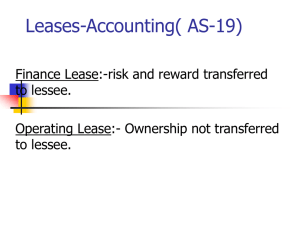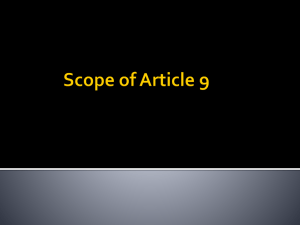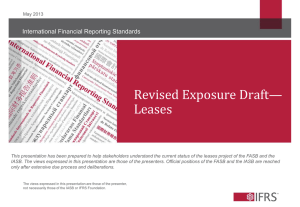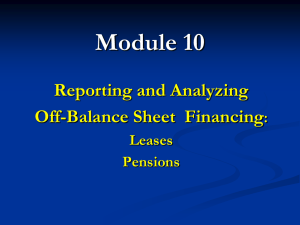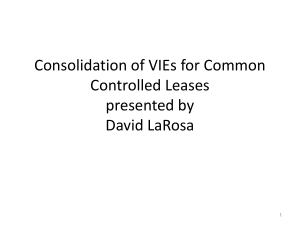Powerpoint slides - Financial Accounting Standards Research
advertisement
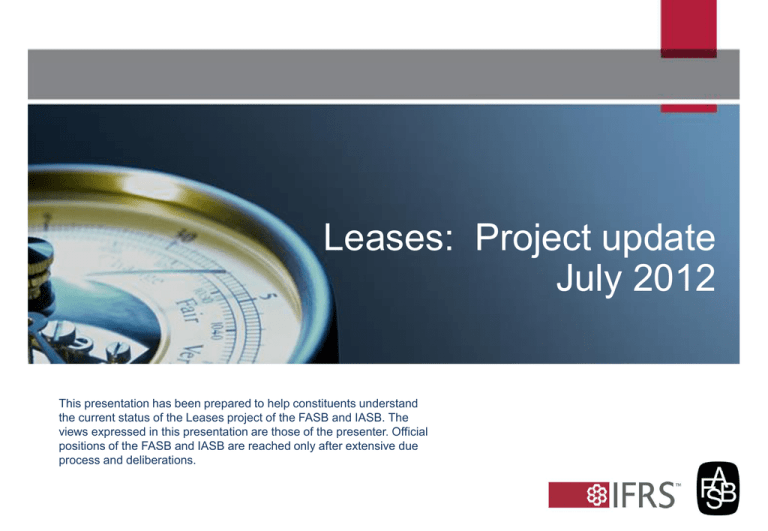
Leases: Project update July 2012 This presentation has been prepared to help constituents understand the current status of the Leases project of the FASB and IASB. The views expressed in this presentation are those of the presenter. Official positions of the FASB and IASB are reached only after extensive due process and deliberations. Agenda • Why a leases project? • Right-of-use model • Lessee accounting model • Lessor accounting model • Classification of leases • Where we are 2 Why a leases project? 3 • Existing lease accounting does not meet users’ needs – accounting depends on classification – contractual rights and obligations (assets and liabilities) are off balance sheet – many users adjust financial statements • Structuring opportunities – current lease classification often based on bright lines – significant difference in accounting on either side of operating/finance lease line Proposed right-of-use model 4 • A lease contract is one in which the right to control the use of an asset (for a period of time) is transferred to the lessee. Lessor Right of use Lessee Redeliberations—lessee model Income statement Balance sheet DR ROU asset 2 CR Lease liability1 5 Lessee consumes more than insignificant portion of leased asset Amortisation expense Interest expense Lessee does not consume more than insignificant portion of leased asset Lease expense 1 Measured at present value of lease payments 2 Initially measured at same amount as liability, plus initial direct costs The rationale (lessee) What the lessee obtains Importance of leased asset How best to reflect those contracts in lessee’s income statement • Right to use an asset • Obligation to pay for that right • Not all leases are the same • 10-year airplane lease => paying to acquire the piece of the airplane consumed plus financing • 3-year real estate lease => paying only for use of the lessor’s asset • Recognise amortisation on ROU asset (and interest on lease liability) when lessee consumes a more than insignificant portion of leased asset • Recognise straight-line lease expense when lessee is paying only for use of the lessor’s asset 6 Redeliberations—lessor model 7 Lessor accounting approach Asset subject to lease Lessee consumes more than insignificant portion of leased asset Receivable and residual approach Lessee does not consume more than insignificant portion of leased asset Approach similar to current operating lease accounting The rationale (lessor) What the lessor provides What the right-of-use represents How best to reflect those contracts in lessor’s financial statements • Lessor provides the lessee with the right to use an asset • Not all leases are the same • 10-year airplane lease => lessor charges the lessee to recover expected consumption of the airplane plus financing • 3-year real estate lease => lessor charges the lessee only for use of the real estate • Recognise lease receivable and retained interest in residual asset when lessee consumes a more than insignificant portion of leased asset • No change to accounting for leased asset and recognise straight-line lease income when lessor charges the lessee only for use of the leased asset 8 Receivable and residual approach Balance Sheet 9 Income Statement Right to receive lease payments1 X Profit on transfer of right-of-use (gross or net based on business model) X Residual asset2 X Interest income—on receivable and residual3 X 1 Present value of lease payments, plus initial direct costs Measured at an allocation of carrying amount of leased asset 3 Interest on residual based on estimated residual value—any profit on the residual asset is not recognised until asset sold or re-leased at end of lease term 2 Lessor approach similar to current operating lease accounting Balance Sheet Leased asset1 10 Income Statement X Rental income2 X Depreciation3, or Fair value changes4 1 (X) X/(X) Lessor measures leased asset (eg property) at fair value (IFRS) or cost 2 Rental income recognised on a straight-line basis or another systematic basis, if more representative of pattern of earning rentals 3 If property measured at cost, rental income plus depreciation recognised 4 If property measured at fair value, rental income plus fair value changes recognised Classification of leases* Lessee consumes more than insignificant portion of leased asset • Leases of assets other than property unless: • Lease term is insignificant relative to economic life of asset • PV of lease payments is insignificant relative to FV of asset * Both lessee and lessor 11 Lessee does not consume more than insignificant portion of leased asset • Leases of property (land and/or a building) unless: • Lease term is major part of economic life of asset • PV of lease payments is substantially all of FV of asset Classification of leases—examples Vessel Truck (4yrs)3 (20yrs)1 Vessel (5yrs)1 More than insignificant Car (3yrs)4 Airplane (8yrs)2 Assumed economic life of: 1 40 years 2 25 years 3 10 years 4 6 years Comm. property (10yrs)1 Insignificant Comm. property (30yrs)1 12 Where we are 2010 2012 13 2012/ 2013 August 2010 Exposure Draft Leases Q4 2012 Second Exposure Draft Leases Comment period 4 months Re-expose proposals Outreach Comment period 120 days Working group meetings Focus on revisions to 2010 proposals Redeliberations 786 comment letters received Contained proposals for both lessees and lessors Will contain proposals for both lessees and lessors Consultation TBD TBD Final Standard Leases Effective date: TBD Will contain guidance for both lessees and lessors Questions or comments? Expressions of individual views by members of the IASB and FASB, and staff are encouraged. The views expressed in this presentation are those of the presenters. Official positions of the IASB and FASB on accounting matters are reached only after extensive due process and deliberation. 14
